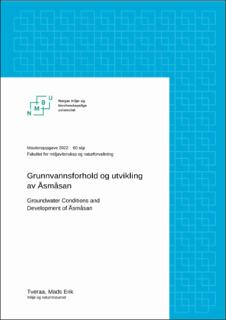| dc.contributor.advisor | Henriksen, Mona | |
| dc.contributor.advisor | French, Helen Kristine | |
| dc.contributor.author | Tveraa, Mads Erik | |
| dc.coverage.spatial | Norway, Akershus, Ås, Åsmåsan | en_US |
| dc.date.accessioned | 2022-11-04T10:09:29Z | |
| dc.date.available | 2022-11-04T10:09:29Z | |
| dc.date.issued | 2022 | |
| dc.identifier.uri | https://hdl.handle.net/11250/3030123 | |
| dc.description.abstract | Bruk av geofysiske metoder for kartlegging av myrområder er mye brukt. Myrområder i seg selv er viktige for jordas karbon-balanse, og kontrollering av vannstand i flomperioder. Det er derfor viktig med gode undersøkelser av myrers utbredelse og grunnforhold.
Åsmåsan, ved Ås i Viken, er en myr der det har blitt bygd opp et karbonlager i form av torv over flere tusen år. Myra er mye undersøkt av studenter og ansatte ved Norges miljø- og biovitenskapelige universitet (NMBU), både gjennom georadar (GPR), resistivitetsmålinger (ERT), kjerneprøver og grunnvannsundersøkelser. Under tidligere kartlegginger med georadar har signalet forsvunnet omtrent halvveis ned i myra, og hva som er grunn i dette er med på å danne grunnlaget for denne oppgaven. Det spekuleres i om dette kan knyttes til marine sedimenter under myrbassenget, eller omdanningen av organisk materiale i myra.
For å si noe om utviklingen av Åsmåsan, samt forklare hva som kan være skyld i forsvinnende georadar-signaler i dypet av myra, er det utført kjemisk og vissuelle analyser av en torvkjerne hentet opp av myra. Undersøkelser med ERT ble også gjennomført, samt grunnvannsmålinger og modellering av grunnvann for å si noe om vannets oppholdstid i myra, og påvirkning fra årstidsvariasjoner av nedbør.
Det er funnet høye verdier av elektrisk ledningsevne (EC) på 110-120 µS/cm, og lave pH-verdier på 3,74, i øvre 2 m av myra. For dypere deler er det funnet forhøyede verdier av Na og EC på henholdsvis 18 mg/L og 130 µS/cm, som trolig kan knyttes til diffusjon fra underliggende marine sedimenter. Målte verdier av EC for øvre 3 m av myra ble benyttet til å beregne penetrasjonsdyp for georadar på 3,5-3,9 m, som samsvarer omtrent med dypet der georadar-signalet forsvinner. Grunnvannsmodellen viser grunnvannsstrømning fra sør mot nord i myra, og det er beregnet oppholdstid for vann mellom 3,5 og 10 år avhengig av dyp i myra. Torvkjernen viser variasjoner av torvtilvekst og nedbrytning, som beskriver et varierende klima fra myras dannelse og fram til i dag. | en_US |
| dc.description.abstract | Geophysical methods are heavily used for mapping of peatlands. Peatlands are an important part of the Earths carbon cycle, and serve as a huge contribution to controlling the water balance in periods of flood. This proves the importance of good mappings of the extent and ground conditions in peatlands.
Åsmåsan, close to Ås in Viken, is a bog in which carbon, in the form of peat, have accumulated over thousands of years. The bog is deeply studied by both students and employees at the Norwegian University of Life Sciences (NMBU), by the means of groundpenetrating radar (GPR), electrical resistivity tomography (ERT), core sampling and groundwater surveys. Previous mappings with GPR show a weakening of signals approximately half way through the bog, and exploiting the reason for this is one of the goals of this research. This might link with marine sediments below the peat basin, or the decomposition of organic matter in the bog.
To explain the development of Åsmåsan, while finding out what is the reason for GPR signals disappearing half way through the bog, a peat core is studied and analyzed. The bog is surveyed with ERT, and measurements of the groundwater level and modelling of the groundwater flow are used to examine the retention time of water, and the effects from seasonal variations of precipitation.
It is found high values of electric conductivity (EC), 110-120 µS/cm, and as low values of pH as 3.74 in the upper 2 m of the bog. For deeper segments it is found raised values of Na and EC, as much as 18 mg/L and 130 µS/cm. This is thought to come from diffusion from marine sediments below. The measured values of EC for the upper 3 m of the bog are used to calculate a penetration depth for GPR at 3.5-3.9 m. This is in accordance with the approximate depth of the disappearing GPR signals. Groundwater modelling show groundwater flow from south to north, and the calculated retention time of water is between 3.5 and 10 years, depending on depth. The peat core show variations in peat growth and decomposition, reflecting a varying climate from the formation of the bog and until today. | en_US |
| dc.language.iso | nob | en_US |
| dc.publisher | Norwegian University of Life Sciences, Ås | en_US |
| dc.rights | Attribution-NonCommercial-NoDerivatives 4.0 Internasjonal | * |
| dc.rights.uri | http://creativecommons.org/licenses/by-nc-nd/4.0/deed.no | * |
| dc.subject | Myrområder | en_US |
| dc.title | Grunnvannsforhold og utvikling av Åsmåsan | en_US |
| dc.title.alternative | Groundwater conditions and development of Åsmåsan | en_US |
| dc.type | Master thesis | en_US |
| dc.description.localcode | M-MINA | en_US |

